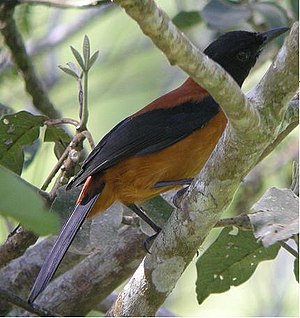Two-color case
This article has been registered in the quality assurance biology for improvement due to formal or content-related deficiencies . This is done in order to bring the quality of the biology articles to an acceptable level. Please help improve this article! Articles that are not significantly improved can be deleted if necessary.
Read the more detailed information in the minimum requirements for biology articles .
| Two-color case | ||||||||||||
|---|---|---|---|---|---|---|---|---|---|---|---|---|

Two-color case |
||||||||||||
| Systematics | ||||||||||||
|
||||||||||||
| Scientific name | ||||||||||||
| Pitohui dichrous | ||||||||||||
| ( Bonaparte , 1850) |
The two-color pitohui ( Pitohui dichrous ) is a species of bird of the genus Pitohui from the family of the orioles (Oriolidae). The name is based on the simple two-tone (black and orange) plumage. The species occurs exclusively in New Guinea , but is not classified as endangered .
Poison
A special feature distinguishes the two-color pitohui: It is next to at least three other (slightly less poisonous) Pitohui species ( monochrome , carrot and ocher pitohui ), the blue-capped flute ( Ifrita kowaldi ) , which also lives in New Guinea, and the forest stubborn ( Colluricincla megarhyncha ) one of the few poisonous birds in the world. The Papuans catch and eat almost all bird species that nature offers them. The two-color pitohui is not one of them, it is considered bitter and can only be enjoyed with luck.
In the early 1990s , ornithologists in New Guinea accidentally discovered the toxicity of this bird species. Studies have subsequently shown that the skin and feathers contain the poison homobatrachotoxin , which is one of the most powerful toxins known and causes muscle cramps .
However, it was unclear how the poison got into the body of the two-color epitohui. In the case of the poison dart frogs (Dendrobatidae) in South America, it has long been suspected that the same poison is not synthesized by the frogs themselves, but is probably ingested through food. This poison is no longer found in the frogs' skin when they are bred in captivity.
Papua New Guinea, researchers have drawn attention to a species of beetle ( Choresine pulchra ) that contains this powerful poison. These beetles are part of the diet of the two-color pitohuis. It can therefore be assumed that this is how the poison gets into the birds' bodies . How the birds protect themselves against it is not yet known.
Etymology and history of research
The first description of the two-color pitohui was in 1850 by Charles Lucien Jules Laurent Bonaparte under the scientific name Rectes dichrous . A type specimen from the Natural History Museum in Leiden was available for analysis. Gustav Hartlaub had already described this under the name Garrulax bicolor in 1844 and it had a label from Salomon Müller with this name. In the Leiden museum, there was another species, the white-cheeked mouse tealet ( Trichastoma bicolor ( Lesson , 1839)), which already included the name bicolor . Thus Bonaparte decided in accordance with the International Rules for Zoological Nomenclature for the new name.
The subspecies Pitohui dichrous monticola Rothschild , 1904, which can still be found occasionally in the literature, is now considered a junior synonym for the nominate form .
The term »Pitohui« is the Papuan name for this bird species, which is based on the Maori word »pitoitoi« for »snapper«. The epithet "dichrous" comes from the Greek word "di- δύο " for "two" and "Khros χρώμα from" for "painting, skin color".
literature
- James A. Jobling: Helm Dictionary of Scientific Bird Names . Christopher Helm, London 2010, ISBN 978-1-4081-2501-4 .
- Gustav Hartlaub: Nouvelles espèces d'oiseaux de L'Inde . In: Revue Zoologique par La Société Cuvierienne . tape 31 , 1844, pp. 401-403 ( online [accessed November 4, 2013]).
- Charles Lucien Jules Laurent Bonaparte: Note sur plusieurs familles naturelles d'Oiseaux, et descriptions d'espèces nouvelle . In: Comptes rendus hebdomadaires des séances de l'Académie des sciences . tape 31 , 1850, pp. 561-564 ( online [accessed November 4, 2013]).
- Lionel Walter Rothschild, 2nd Baron Rothschild: The Hon. Walter Rothschild, Ph.D, sent for exhibition an example of a new Pitohui, which he described as follows . In: Bulletin of the British Ornithologists' Club . tape 14 , 1904, pp. 79 ( online [accessed November 4, 2013]).
Web links
- Pitohui dichrous inthe IUCN 2013 Red List of Threatened Species . Listed by: BirdLife International, 2012. Retrieved November 24, 2013.
- BirdLife International: Species Factsheet - Hooded Pitohui ( Pitohui dichrous ) . Retrieved November 4, 2013.
- Videos, photos and sound recordings for Hooded Pitohui (Pitohui dichrous) in the Internet Bird Collection
- Two-color pitohui ( Pitohui dichrous ) at Avibase; Retrieved November 4, 2013.
- Pitohui dichrous in the Integrated Taxonomic Information System (ITIS). Retrieved November 4, 2013.
- xeno-canto: Sound recordings - Hooded Pitohui ( Pitohui dichrous )
- John W. Daly, John P. Dumbacher: Melyrid beetles (Choresine): A putative source for the batrachotoxin alkaloids found in poison-dart frogs and toxic passerine birds. PNAS November 2004
Individual evidence
- ↑ Pitohui dichrous in the IUCN Red List of Threatened Species 2013.2. Listed by: BirdLife International, 2012. Retrieved November 24, 2013.
- ^ A b Charles Lucien Jules Laurent Bonaparte, p. 563.
- ↑ Gustav Hartlaub, p. 402.
- ^ Lionel Walter Rothschild, p. 79.
- ^ IOC World Bird List Vireos, crows, and allies ( Memento of April 5, 2014 in the Internet Archive )
- ↑ James A. Jobling, p. 308.
- ↑ James A. Jobling, p. 135.